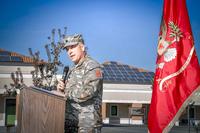Forty miles southwest of the Pribilof Islands, Coast Guard Cutter Munro navigated shifting ice fields to close on the Bering Sea’s largest fishing fleet. Arctic winds whipped through the bridge’s opened door at sunrise while crewmembers cleaved ice on the forecastle and engineers looked over the ready boat to make sure its systems wouldn’t freeze up.
These frozen conditions don’t sound ideal for most people. Then again, most people aren’t crewmembers aboard Munro.
“I’d rather drive up here than in the Florida Straits,” said Lt. j.g. Evan Richter, an officer aboard Munro. “Ice or no ice, we need to be near the fleet.”
By the afternoon, that mentality would pay off for a sailor in need.
While the weapons and operations departments were wrapping up the day’s second boarding, a radio call reached Munro’s bridge from fishing vessel Nordic Fury, then only three miles away. A member of their crew had suffered deep lacerations to his hand, which had been partially crushed freeing a net fouled in the vessel’s screws.
Petty Officer 3rd Class Ian Miller, an operations specialist, worked with the 17th Coast Guard District command center who had been in communication with Nordic Fury. Because the 95-foot boat could not pull in to nearby Saint Paul Harbor due to icing conditions, it was decided the injured fisherman should be brought aboard Munro for examination.
The cutter’s 23-foot rescue boat was launched in an ice-cold chop to retrieve the fisherman and brought him aboard Munro.
“It wasn’t routine. We were looking at six foot swells,” said the coxswain, Petty Officer 3rd Class Michael Valdes.
The maneuver was made even riskier by icy rails on the Nordic Fury and the need to assist the patient – with only one good hand – down the ladder into their rescue boat.
“The location of their ladder made things harder too. I had to come in opposite their course to maintain position against their hull. I couldn’t have done it safely without my crew,” added Valdes.
When the boat returned, Chief Petty Officer Joshua Foss, a health services technician, was ready in sick bay.
“They had done a good job with the first aid,” said Foss. “The next step was to debride [clean] and assess the wound.”
Foss skillfully observed that the patient’s injury had not affected tendons or ligaments and that suture would be appropriate. Normally, Coast Guard health services technicians are not called to complete clinical tasks on civilian patients, but the district’s duty surgeon made an exception, with further medical help days away in Dutch Harbor. Foss applied local anesthesia, approximated the wound and, as excessive swelling indicated the bone may have been fractured, he applied a splint and advised his patient to get imaging done ashore.
The fisherman was very grateful: “Thank God you guys were out there,” he said, “There wouldn’t have been any other help for me so soon.” He was transferred back to Nordic Fury, which steamed south for Dutch Harbor.
It was a massive team effort to help the fisherman in need, from the operations specialist to the boat coxswain. Munro, steaming in the Arctic, was ready for it, though. The crew remains Always Ready each day on the Bering; a place where their days are far from “routine.”




























